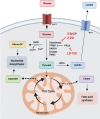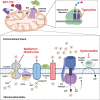Metabolic dependencies and vulnerabilities in leukemia
- PMID: 31676734
- PMCID: PMC6824464
- DOI: 10.1101/gad.326470.119
Metabolic dependencies and vulnerabilities in leukemia
Abstract
Leukemia cell proliferation requires up-regulation and rewiring of metabolic pathways to feed anabolic cell growth. Oncogenic drivers directly and indirectly regulate metabolic pathways, and aberrant metabolism is central not only for leukemia proliferation and survival, but also mediates oncogene addiction with significant implications for the development of targeted therapies. This review explores leukemia metabolic circuitries feeding anabolism, redox potential, and energy required for tumor propagation with an emphasis on emerging therapeutic opportunities.
Keywords: Warburg effect; glycolysis; leukemia; metabolism; mitochondria; targeted therapy.
© 2019 Rashkovan and Ferrando; Published by Cold Spring Harbor Laboratory Press.
Figures




References
-
- Advani AS, Li H, Michaelis LC, Medeiros BC, Liedtke M, List AF, O'Dwyer K, Othus M, Erba HP, Appelbaum FR. 2018. Report of the relapsed/refractory cohort of SWOG S0919: a phase 2 study of idarubicin and cytarabine in combination with pravastatin for acute myelogenous leukemia (AML). Leuk Res 67: 17–20. 10.1016/j.leukres.2018.01.021 - DOI - PMC - PubMed
Publication types
MeSH terms
Grants and funding
LinkOut - more resources
Full Text Sources
Other Literature Sources
Medical
